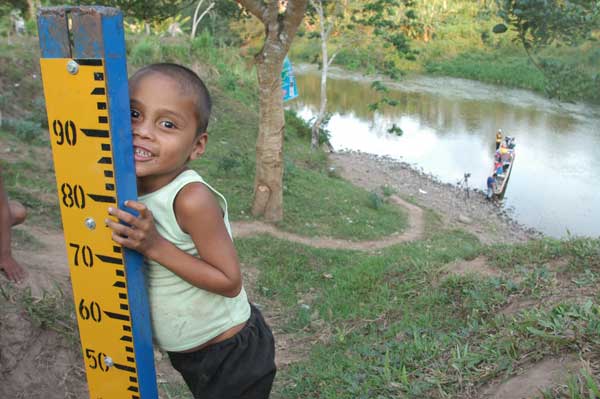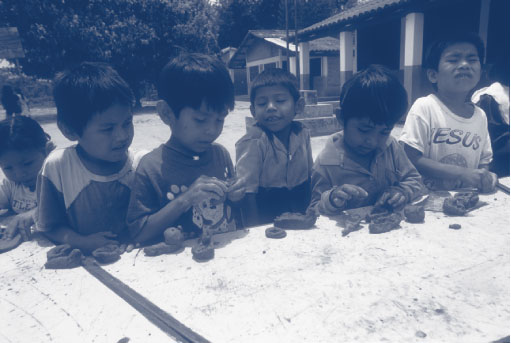Community-Based Methodologies for Risk Identification and Education:
An Opportunity for Risk Management and Local Development

Photo: © OXFAM/David Vinyuales
The impacts of natural disasters on economic and social infrastructure are well demonstrated and documented. But, in many cases, events of lesser scale that occur in isolated communities are not taken into account in any registry or in activities aimed at reducing risk. Sometimes they even go by unnoticed by the local authorities themselves. Because of this, promoting and developing participatory technical, economic and administrative actions regarding risk management at the community level could be a tool that allows communities themselves to lead efforts, in coordination with local authorities, to reduce existing risks in their respective areas. The Hyogo Framework for Action 2005–2015, which establishes guidelines for reducing the impact of natural disasters by increasing the resilience of vulnerable communities to natural hazards, considers and promotes decentralization of natural disaster risk management: “Many activities for managing disaster risks should be implemented at provincial, municipal, and local levels, since the risks that populations face are specific to each particular geographic area.”
For that reason, several regional aid organizations and government institutions have been working on a number of actions at the community level. Among these actions, it is important to highlight the development of methodologies that advance education for risk management and identification at the community level, especially in the areas of health and education, based on the premise that education is one of the most effective ways to reduce risk on a regional scale. The hope is that what children and young students learn at school will be applied in their homes and communities, substantiating the fact that a well-prepared school is one of the foundations for a well-prepared community. In this context, the UN International Strategy for Disaster Reduction (UN/ISDR), UNICEF, the International Federation of Red Cross and Red Crescent Societies (IFRC), Plan International, and the European Commission’s Humanitarian Aid Office (ECHO) developed an educational toolkit aimed at providing communities in Latin America and the Caribbean with support material that can be used by teachers, specialists, and community leaders, among others. The toolkit mainly serves to spread the message about the importance of integrating risk management into everyday activities in a community, by including this issue in school curricula, building capacity, and increasing the physical resilience of houses and social infrastructure.
Some examples of the tools developed in this process, and perhaps the most representative, are the series of modules titled “It is better to prevent,” and the Analysis of Vulnerabilities and Capacities (AVC), developed between 2005 and 2007 by the IFRC, with the support of ECHO, the OAS Department of Sustainable Development (OAS/DDS), and the ProVention Consortium. These are valuable community-based risk management tools that support communities in identifying and developing activities aimed at reducing risks and building their capacity. The tools generate added value regarding other actions underway because, due to their participatory and consultative methodological approach, they create a space of trust and commitment within the communities involved, as well as among other stakeholders.
Process of formulating and applying the methodologies
The process of formulating and applying these methodologies dates back to 2004 and 2005, when the International Federation of Red Cross and Red Crescent Societies (IFRC) and the General Secretariat of the OAS, through its Department of Sustainable Development (DSD), with the financial support of the ProVention Consortium, developed the AVC as a community-based educational tool for natural disaster risk reduction, and carried out participatory assessments in selected communities in Belize, Costa Rica, Guatemala, and Honduras. In 2008, the OAS/DSD, the IFRC, and the ProVention Consortium took up this work again to develop the second phase of the initiative. This new stage drew on the earlier assessments and sought to build the capacity of the National Red Cross Societies, government authorities, and local communities. This phase included two new communities in Rio de Janeiro, Brazil. Based on the participatory assessments, 16 communities were selected from the 4 aforementioned Central American countries and, and in coordination with the respective National Red Cross Societies, one micro-project was developed in each participating community.
Public and private participation: Towards Public-Private partnerships
The IFRC and the OAS Department of Sustainable Development carried out a process for exchanging and sharing experiences through the holding of national forums in these four Central American countries. Although some important actors were absent, there was a balanced representation of all sectors, including government institutions, chambers of commerce, private companies, aid organizations, and the communities themselves.
One of the main conclusions of this process was the need for greater, more effective, and more committed involvement of the different government levels in this initiative, starting from the initial phase, which focuses on applying the methodologies. Evidently, there is the need for active participation by local municipal governments in order to provide advice and technical assistance to these communities. Participation of relevant national institutions, such as national emergency systems and technical institutes responsible for hydro-meteorological and seismological monitoring, has also proven to be a determining factor for a successful application of these tools. Participation of local and central governments is a sine qua non condition for the technical, financial, and institutional viability of the mitigation projects and measures identified through the use of these tools.
For example, in the case of the micro-projects developed in the communities of Puerta del Jardín and Nuestra Señora del Carmen in Guatemala, we see the pivotal role played by local and national governments, and the need to integrate them into these processes. In Puerta del Jardín, participation of the municipality of Guatemala City resulted in a technical report that it issued to designate the area where the community settles as uninhabitable. Additionally, it recommended that all infrastructure projects be suspended, so as not to encourage settlers to stay in this high-risk area or to generate greater secondary risks. In the community of Nuestra Señora del Carmen, the micro-project proposed by the community was reviewed by specialists and a technical file was created to detail the work to be carried out, the cost of materials, and the labor required, which will be performed by members of the community itself. As a result, the project is technically and financially viable and has the endorsement of the municipality and all corresponding permits, which will allow it to move forward with greater diligence.
On the other hand, we have seen that the lack of institutional capacity in the area of risk management, the lack of coordination among the different government levels, the lack of follow-up regarding existing inter-institutional agreements, and the lack of knowledge about the law make it difficult to implement coordinated actions and ensure continuity from one initiative to the next. We have also observed that local governments show a great deal of willingness and interest, often times through the personal efforts of officials who go above and beyond their own duties, sacrificing their family time and rest. However, social urgencies do not allow them to step back from a “state of emergency” in order to focus on strategic planning to address the full dimensions of existing risks.
Participation of the private sector is equally necessary to ensure the financial and economic viability of the mitigation measures proposed. In some cases, companies have plenty of technical information and capacity to support studies and project designs. We have seen great interest on the part of the private sector to participate in developing initiatives related to risk management. Many companies and unions are working to establish specialized units within their organization structures, and to carry out training and monitoring activities. Nevertheless, such initiatives are directed, above all, towards disaster response and preparedness. And there is still reluctance on the part of some chambers of commerce and private companies to participate in these projects because risk management is still not one of their main priorities.
To a large extent, the differences related to the level of participation of the private sector and the government also reflect differences in the level of development of each participating country. In cases such as the communities in Costa Rica there is greater integration of the private sector and local governments in the process of evaluating and mitigating risk, in comparison to the case of Guatemala, where participation of the private sector is still incipient.
There is a clear need to advance public-private partnerships, ensure transparency in public administration and, consequently, generate greater trust in the private sector, as well as to make more rational use of existing resources, and thus achieve greater participation and investment in vulnerability reduction and disaster mitigation. While corporate social responsibility is viewed as an important driving force for the private sector, a public policy that includes a number of economic incentives, such as tax deductions and protection of workers integrity and that of their families –in order to ensure the normal continuity of their activities (business continuity)– is another sine qua non condition for applying these tools, as well as for the financial and economic viability of mitigation projects. This is also essential for formulating local cooperation strategies in which there is real and broad-based participation of the different sectors in decision- making processes advanced by all relevant institutions.
A Process of harmonization and institutionalization
Finally, the main obstacle to implementing these initiatives at the regional level lies in the absence of regulations and their official recognition by the States, which ultimately are responsible for guaranteeing the safety and well-being of the communities. Also, the lack of indicators makes it impossible to monitor and evaluate the measures developed by States to reduce vulnerability, which in turn makes it difficult to implement them.
Experience in applying different types of methodologies, whether developed by aid organizations or States, demonstrates the need to begin a process of harmonization and institutionalization of their structure and content. Such a process would contribute to developing indicators and would guarantee equitable benefits based on the characteristics of each community where these methodologies are applied.
The aforementioned process can only be achieved through dialogue with decision makers and policymakers about risk management to discuss technical, political, economic and social aspects; identify best practices, and prepare agreements and work plans for the short and medium term, in coordination with countries involved and cooperation agencies, such as UNICEF, the UN/ISDR, OFDA, the IFCR, and the OAS Department of Sustainable Development.

|